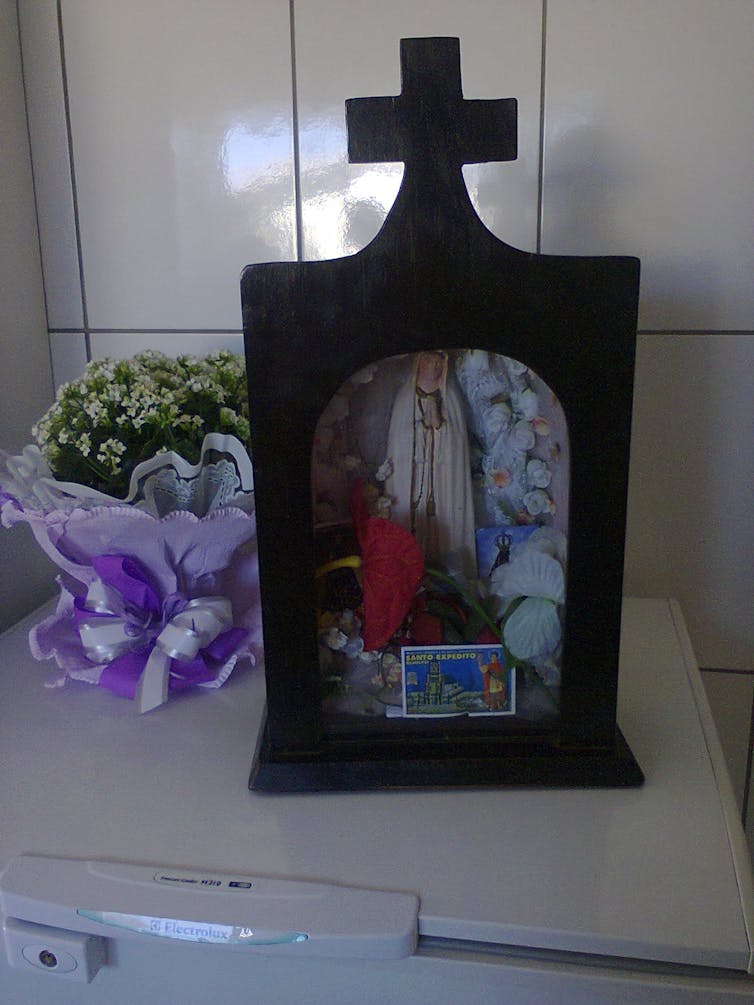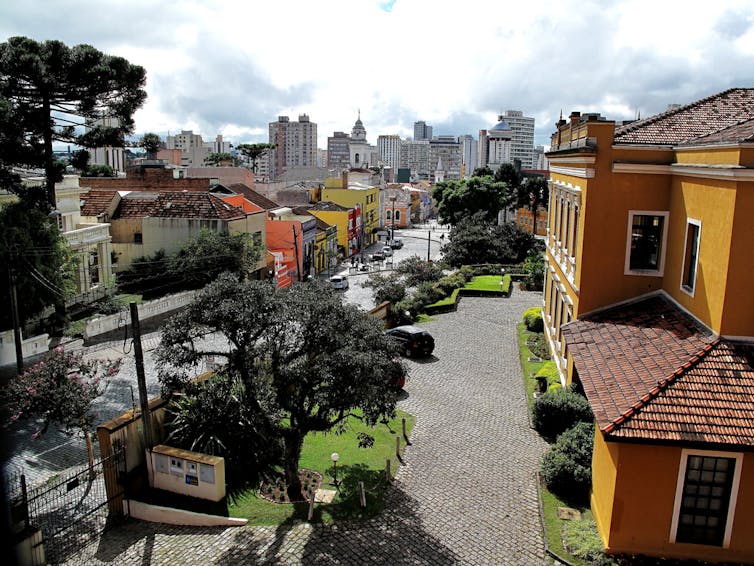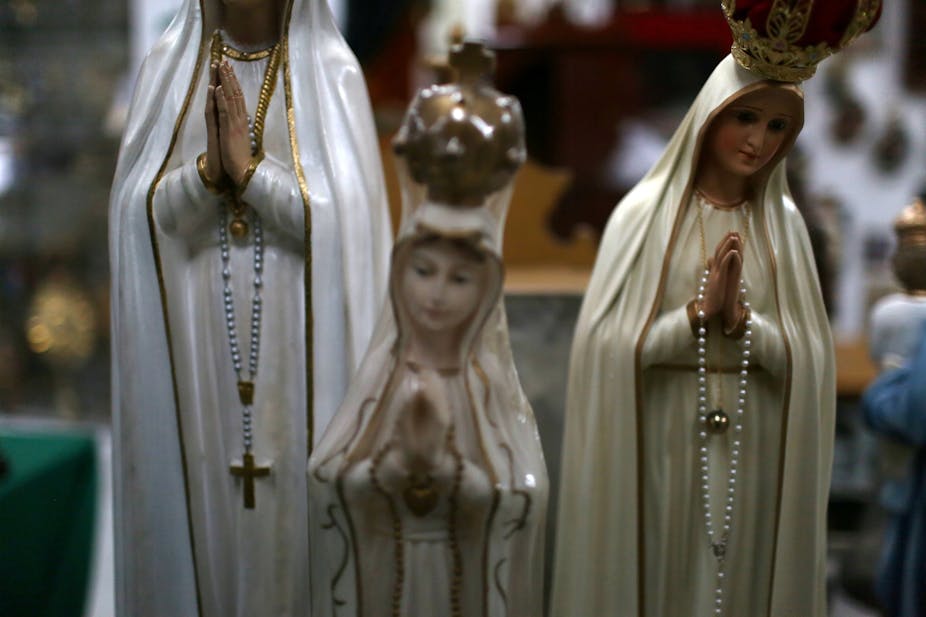Brazilians are moving away from Catholicism. Today, fewer than 50 percent of Brazilians identify as Roman Catholic, down from 92 percent in 1970. But after 500 years in South America, the Catholic Church remains deeply enmeshed Brazil’s economy and society.
Among its many footholds is a little-known tradition called the Movimento das Capelinhas, or “small chapel movement.” This phenomenon, which takes place in hundreds of cities and towns across Brazil, centers on the circulation among Catholic households of small sanctuaries containing a Virgin Mary statuette.
Alternative economies on the rise
The Movimento das Capelinhas is an example of a circulation-based collaborative network, a kind of hyper-local economy that is popping up across the globe, from one London district’s alternative currency to the time banks of New Zealand.
Such systems appeal because they exchange a narrow focus on economic value (only money matters) for a broader definition of what has value to people. By circulating dear objects in a certain pattern, these collaborative networks distribute their benefits to all involved, and the “profit” goes well beyond the small economic bump communities may see.
The small chapel movement forms part of a long history of Roman Catholic rituals involving sacred relics and statues sent out to tour the world’s parishes.
Protected by their wooden homes, Brazil’s moving Marys pay one-day “visits” to various parishioners’ homes in a semi-formal process determined by neighbors, parishes and lay volunteers. Most chapel groups include about 30 families, such that each family receives one visit a month. Local clergy oversee the Marys’ progress around town.

In doing their rounds, our research found, these peripatetic chapels do more than just physically circulate – their travels actually create profit and value for participants. The end result is a de facto local Catholic “economy,” one based on shared values rather than money.
Rituals and relics
To understand the economic impact of the popular small chapel tradition, we spent two years studying the Marys’ circulation in two southern Brazilian cities: Curitiba, which has 1.76 million residents; and Campos Novos, a small town southwest of there.
Our study, which was published in February in the Journal of Macromarketing, found differences in the size and organizational level of each city’s small chapel movements. But in both places, everyone in this ritual receives some kind of benefit, be it economic, spiritual or social – creating what’s called “hybrid value systems.”
Curitiba’s system is well-coordinated by the church, with approximately 100 volunteer mensageiras (messengers) who steward an estimated 10,000 small chapels from household to household.

In Campos Novos, which has 32,800 inhabitants, the market was less robust. Approximately 100 Marys circulate among local Catholics, overseen by about the same number of mensageiras.
For participating communities in both cities, the effect of the moving chapels is to create an alternative economy, one based not on traditional capitalist values but on participation, community and faith.
Money does, of course, play some role. Households make monetary donations to the Catholic Church for the honor of hosting a chapel. Some small capelinhas even come equipped with their own coin slot.
In Curitiba, we found that these small contributions earn the church about 1.5 million Brazilian reals (approximately US$500,000) per year. In Campos Novos, the church’s profit was significantly less, likely garnering the local archdiocese just several thousand reals.

Money can’t buy you faith
Host families and community members see less tangible but equally valuable benefits from the traveling Marys.
For lay mensageiras, it’s social status: Working as your neighborhood’s representative of the church is a prestigious role. Likewise for the families, parishes and communities interconnected by the regular visitation of these small chapels.
There is a spiritual value, too. For Catholics, Mary, as the mother of Jesus Christ, is one of the most powerful holy figures, and recipients of the small chapels that house her feel blessed by their access to divinity, support and good luck.
The Brazilian Catholic church carefully manages this aspect of the chapel visits, presenting them as a source of comfort. The Marys “move,” says Church doctrine, and in doing so sustain their devotees emotionally.
The capelinhas often become a favored local symbol of their family group, transcending their religious significance to be, quite simply, beloved and familiar objects.
The Curitiba archdioscese’s Movimento das Capelinhas Facebook page and blog reveals host families, messengers and priests celebrate the traveling Marys. After one family posts about a chapel’s arrival to their home, other commentators excitedly retell their visitation stories.

The church also takes to Facebook and to the pulpit to recognize the volunteers who help to circulate the chapels, even honoring them in special Masses. Lauding participants in the small chapel movement gives them a special social status, or what we call “reputational value” – another benefit created by this alternative economy.
The church actively promotes the social and reputational value of the Marys. When a new church opens in town, for example, the small chapels will be given new circulation routes as a welcome to new parishioners.
Priests in Curitiba train and mentor the small chapel messengers, helping to ensure that the Marys circulate in ways that mutually benefit all participants, either economically, spiritually, socially or on multiple levels.
One type of value often translates into another. Spiritual value becomes economic whenever someone donates to a small chapel, for example. Then, when this money, in turn, is used to educate an apprentice priest or to introduce a new route for a small chapel, the value again changes, becoming social or reputational.
Brazil’s “Marys that move” may not be able to pull Brazil out of its deep recession, but our research reveals that these hybrid systems do hold the potential to combat economic malaise, albeit on the local level, by reminding Catholics that even if money is in short supply right now, friends, family and faith are not.

